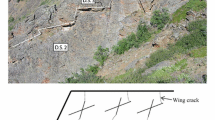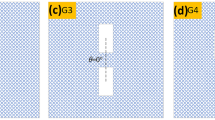Abstract
Pre-existing flaws often exist near horseshoe-shaped cavities in practical rock engineering projects. The adjacent flaws can affect the failure mode of horseshoe-shaped cavities. In this paper, we use a combination of laboratory experiments and numerical simulations to explore the effect of an adjacent flaw on the failure mode of a horseshoe-shaped cavity. In the experimental tests, the length and distance of the adjacent flaw are taken as the variables to prepare the specimens, which are then loaded under uniaxial and biaxial compression conditions. Our experimental results show that when an adjacent flaw exists near a horseshoe-shaped cavity, cracks are initiated from the vaults and arches of the horseshoe-shaped cavity, rather than from the adjacent flaw. Subsequently, this phenomenon is verified by the M-integral theory in fracture mechanics. Moreover, the testing results show that the propagation path of the new cracks is attracted by the adjacent flaw. As the length of the adjacent flaw increases or the distance between the flaw and the cavity decreases, the attraction from the flaw tip to the new cracks increases.
Highlights
-
The effect of adjacent flaw on the failure mode of horseshoe–shaped cavity was studied
-
The effect of adjacent flaw length and distance on the crack propagation was investigated
-
The attraction of adjacent flaw and the crack initiation location were explained














Similar content being viewed by others
Data Availability
The data that support the fingdings of this study are available from the corresponding author upon reasonable request.
Abbreviations
- C :
-
The closed path surrounding the defect
- D :
-
Distance between the highest point of the cavity and the middle point of the flaw
- i :
-
The partial derivative of coordinate xi
- L :
-
Length of the flaw
- n i :
-
Normal direction vector of the integral path
- T k :
-
Normal stress vector outside the integral path
- σ v :
-
Vertical load
- σ h :
-
Horizontal load
- w :
-
Strain energy density
- α :
-
Angle between the adjacent flaw and the vertical principal stress
References
Atkinson C, Cook JM (1993) Effect of loading rate on crack propagation under compressive stress in a saturated porous material. J Geophys Res-Sol Ea 98(B4):6383–6395
Bankun MD, Hatzor YH, Dershouitz WS (2009) Modeling mechanical layering effects on stability of underground openings in jointed sedimentary rocks. Int J Rock Mech Min 46(2):262–271
Bieniawski ZT (1967) Mechanism of brittle fracture of rock, Parts I, II and III. Int J Rock Mech Mining Sci 4:395–430
Brady BHG, Brown ET (2006) Rock mechanics for underground mining. Springer, Dordrecht
Browning J, Meredith PG, Stuart CE, Healy D, Harland S, Michell TM (2017) Acoustic characterization of crack damage evolution in sandstone deformed under conventional and true triaxial loading. J Geophys Res-Sol Ea 122(6):4395–4412
Cai M, Kaiser PK, Tasaka Y, Maejima T, Morioka H, Minami M (2004) Generalized crack initiation and crack damage stress thresholds of brittle rock masses near underground excavations. Int J Rock Mech Min 41(5):833–847
Cheng XS, Dowding CH, Tian RR (2014) New methods of safety evaluation for rock/soil mass surrounding tunnel under earthquake. J Cent South Univ 21(7):2935–2943
Deng YY, Chen CX, Xia KZ, Yang KY, Sun CY, Zheng XW (2018) Investigation on the characteristics of overlying strata caving in the Chengchao Iron Mine. Environ Earth Sci 77(10):362
Diederichs MS, Kaiser PK, Eberhardt E (2004) Damage initiation and propagation in hard rock during tunneling and the influence of near-face stress rotation. Int J Rock Mech Min 41(5):785–812
Ding XL, Niu XQ, Pei QT, Huang SL, Zhang YT, Zhang CH (2019) Stability of large underground caverns excavated in layered rock masses with steep dip angles: a case study. B Eng Geol Environ 78(7):5101–5133
Duan SQ, Feng XT, Jiang Q, Liu GF, Pei SF, Fan YL (2017) In situ observation of failure mechanisms controlled by rock masses with weak interlayer zones in large underground cavern excavations under high geostress. Rock Mech Rock Eng 50(9):2465–2493
Duan K, Kwok CY, Zhang QY, Shang JL (2020) On the initiation, propagation and reorientation of simultaneously-induced multiple hydraulic fractures. Comput Geotech 117:103226
Eberhardt E, Stead D, Stimpson B (1999) Quantifying progressive pre-peak brittle fracture damage in rock during uniaxial compression. Int J Rock Mech Min 36(3):361–380
Eberhardt E, Stimpson B, Steed D (2017) Effects of grain size on the initiation and propagation thresholds of stress-induced brittle fractures. Rock Mech Rock Eng 32(2):81–99
Feng XT, Pei SF, Jiang Q, Zhou YY, Li SJ, Yao ZB (2017) Deep fracturing of the hard rock surrounding a large underground cavern subjected to high geostress: in situ observation and mechanism analysis. Rock Mech Rock Eng 50(8):2155–2175
Gao CL, Zhou ZQ, Li ZH, Li LP, Cheng S (2020) Peridynamics simulation of surrounding rock damage characteristics during tunnel excavation. Tunn Undergr Sp Tech 97:103289
Grendas N, Marinos V, Papathanassiou G, Ganas A, Valkaniotis S (2018) Engineering geological mapping of earthquake-induced landslides in South Lefkada Island, Greece: evaluation of the type and characteristics of the slope failures. Environ Earth Sci 77(12):425
Guan K, Zhu WC, Niu LL, Wang QY (2017) Three-dimensional upper bound limit analysis of supported cavity roof with arbitrary profile in Hoek-Brown rock mass. Tunn Undergr Sp Tech 69:147–154
Hoek E, Brown ET (1980) Empirical strength criterion for rock masses. J Geotech Eng Div ASCE 106(9):1013–1035
Huang YH, Yang SQ, Ranjith PG, Zhao J (2017) Strength failure behavior and crack evolution mechanism of granite containing pre-existing non-coplanar holes: experimental study and particle flow modeling. Comput Geotech 88:182–198
Huang YH, Yang SQ, Hall MR, Tian WL, Yin PF (2018) Experimental study on uniaxial mechanical properties and crack propagation in sandstone containing a single oval cavity. Arch Civ Mech Eng 18(4):1359–1373
Klimchouk A, Andrejchuk V (2005) Karst breakdown mechanisms from observations in the gypsum caves of the Western Ukraine: implications for subsidence hazard assessment. Environ Geol 48(3):336–359
Kwok CY, Duan K, Pierce M (2020) Modeling hydraulic fracturing in jointed shale formation with the use of fully coupled discrete element method. Acta Geotech 15(1):245–264
Li Q, Guo YL, Hou JL, Zhu WJ (2017) The M-Integral based failure description on elasto-plastic materials with defects under biaxial loading. Mech Mater 112:163–171
Li SC, Liu B, Ren YX, Yang SL, Chen YK, Wang YH, Jiang P (2020) Deep-learning Inversion of Seismic Data. IEEE T Geosci Remote 58(3):2135–2149
Liu B, Pang YH, Mao DQ, Wang J, Liu ZY, Wang N, Liu SH, Zhang XX (2020) A rapid four-dimensional resistivity data inversion method using temporal segmentation. Geophys J Int 221(1):586–602
Lou ZQ, Xie CY, Zhou JM, Jia N, Liu XM, Xu H (2015) Numerical analysis of stability for mined-out area in multi-field coupling. J Cent South Univ 22(2):669–675
Lu YE, Yang W (2013) Analytical solutions of stress and displacement in strain softening rock mass around a newly formed cavity. J Cent South Univ 20(5):1397–1404
Ma K, Tang CA, Xu NW, Liu F, Xu JW (2013) Failure precursor of surrounding rock mass around cross tunnel in high-steep rock slope. J Cent South Univ 20(1):207–217
Marinos P, Hoek E (2001) Estimating the geotechnical properties of heterogeneous rock masses such as flysch. B Eng Geol Environ 60(2):58–92
Martin CD, Chandler NA (1994) The progressive fracture of Lac Du Bonnet granite. Int J Rock Mech and Min 31(6):643–659
Paraskevopoulou C, Perras M, Diederichs M, Amann M, Low S, Lam T, Jensen M (2017) The three stages of stress relaxation - Observations for the time-dependent behaviour of brittle rocks based on laboratory testing. Eng Geol 216:56–75
Qian QH, Zhou XP (2018) Failure Behaviors and Rock Deformation During Excavation of Underground Cavern Group for Jinping I Hydropower Station. Rock Mech Rock Eng 51(8):2639–2651
Shi SS, Zhao RJ, Li SC, Xie XK, Li LP, Zhou ZQ, Liu HL (2019) Intelligent prediction of surrounding rock deformation of shallow buried highway tunnel and its engineering application. Tunn Undergr Sp Tech 90:1–11
Song F, Wang HN, Jiang MJ (2018) Analytical solutions for lined circular tunnels in viscoelastic rock considering various interface conditions. Appl Math Model 55:109–130
Sun XM, Chen F, Miao CY, Song P, Li G, Zhao CW, Xia X (2018) Physical modeling of deformation failure mechanism of surrounding rocks for the deep-buried tunnel in soft rock strata during the excavation. Tunn Undergr Sp Tech 74:247–261
Tao M, Zhao HT, Li ZW, Zhu JB (2020) Analytical and numerical study of a circular cavity subjected to plane and cylindrical P-wave scattering. Tunn Undergr Sp Tech 95:103143
Tunsakul J, Jongpradist P, Kim HM, Nanakorn P (2017) Evaluation of rock fracture patterns based on the element-free galerkin method for stability assessment of a highly pressurized gas storage cavern. Acta Geotech 13(4):817–832
Walton G, Alejano LR, Arzua J, Markley T (2018) Crack damage parameters and dilatancy of artificially jointed granite samples under triaxial compression. Rock Mech Rock Eng 51(6):1637–1656
Wang XS, Jiang YJ, Li B (2017) Experimental and numerical study on crack propagation and deformation around underground opening in jointed rock masses. Geosci J 21(2):291–304
Xu J, Li ZX (2017) Damage evolution and crack propagation in rocks with dual elliptic flaws in compression. Acta Mech Solida Sin 30(6):573–582
Yang XL, Zou JF, Sui ZR (2007) Effects of intermediate principal stress on rock cavity stability. J Cent South Univ Technol 14:165–169
Yu NY, Li Q (2013) Failure theory via the concept of material configurational forces associated with the m-integral. Int J Solids Struct 50:4320–4332
Zhang ZJ, Li LH, Xu WJ, Fu Y, Feng J (2015) Flat-plate roof collapse of shallow caverns and protective measures: a case study of Longyou ancient siltstone caverns. Nat Hazards 76(1):194–213
Zhang DB, Liu ZZ, Zhang JH (2017) A new failure mechanism for deep cavity and upper bound solution of supporting pressure. J Cent South Univ 24(9):2082–2091
Zhao GP, Yang SL (2015) Analytical solutions for rock stress around square tunnels using complex variable theory. Int J Rock Mech Min 80:302–307
Zhao XD, Zhang HX, Zhu WC (2014) Fracture evolution around pre-existing cylindrical cavities in brittle rocks under uniaxial compression. T Nonferr Metal Soc 24(3):806–815
Zhao LH, Huang S, Zhang R, Zuo S (2018) Stability analysis of irregular cavities using upper bound finite element limit analysis method. Comput Geotech 103:1–12
Zhao ZL, Jing HW, Shi XS, Gao Y (2020) Experimental and numerical research on fracture behaviors of sandstone under different loading rates. Geomech Geophys Geo 6(4):61
Zhong ZB, Deng RG, Lv L, Fu XM, Yu J (2018) Fracture mechanism of naturally cracked rock around an inverted u-shaped opening in a biaxial compression test. Int J Rock Mech Min 103:242–253
Zhou ZL, Tan LH, Cao WZ, Zhou ZY, Cai X (2017) Fracture evolution and failure behaviour of marble specimens containing rectangular cavities under uniaxial loading. Eng Fract Mech 184:183–201
Acknowledgements
This paper is funded by the National Natural Science Foundation of China (NO. 51879151, 51909138, 51909142, 42272311).
Author information
Authors and Affiliations
Corresponding authors
Additional information
Publisher's Note
Springer Nature remains neutral with regard to jurisdictional claims in published maps and institutional affiliations.
Rights and permissions
Springer Nature or its licensor (e.g. a society or other partner) holds exclusive rights to this article under a publishing agreement with the author(s) or other rightsholder(s); author self-archiving of the accepted manuscript version of this article is solely governed by the terms of such publishing agreement and applicable law.
About this article
Cite this article
Zhang, B., Zhu, P., Zhang, J. et al. Effect of an Adjacent Flaw on the Crack Propagation of a Horseshoe-Shaped Cavity. Rock Mech Rock Eng 56, 1807–1821 (2023). https://doi.org/10.1007/s00603-022-03132-y
Received:
Accepted:
Published:
Issue Date:
DOI: https://doi.org/10.1007/s00603-022-03132-y




